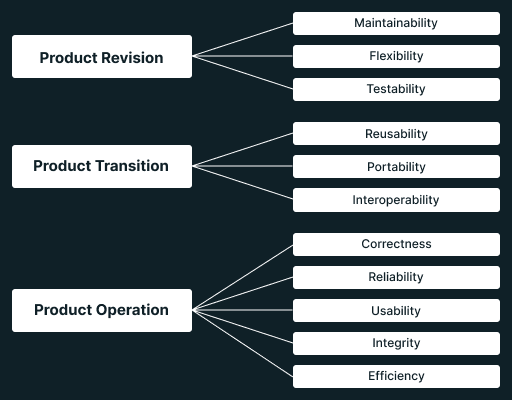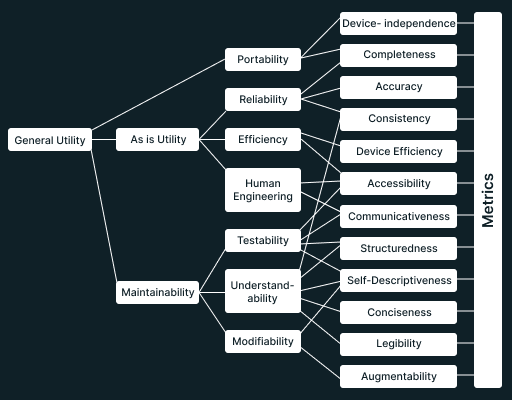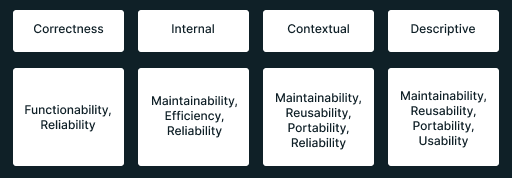Software Quality Management: Techniques With Best Practices
- Learning Hub
- Software Quality Management: Techniques With Best Practices
CHAPTERS
- Overview
- What is Software Quality
- Why is Software Quality important for businesses
- Key factors to determine Software Quality
- Benefits of Software Quality
- Different Models for Software Quality
- What are Software Quality Metrics
- Important Software Quality Metrics
- How to ensure Software Quality
- Best practices to enhance the Software Quality
- Frequently Asked Questions (FAQs)
OVERVIEW
Software quality describes the characteristics of a software product that make it capable of meeting the needs of its users and stakeholders. Basically, it measures how well a piece of software performs the functions for which it was designed, as well as how well it complies with its requirements. The quality of a software product can play an important role in its success and users' satisfaction.
According to a report, the economic impact of bad software quality in the US is approximately $2.08 trillion. It covers failed software projects, inadequate software quality in legacy systems, and operational software failures. Besides the monetary loss, bad software quality tarnishes the brand's reputation.
Therefore, it’s impossible to overlook the significance of software quality. Adhering to software quality standards reduces time and cost and increases the overall efficiency of the software development life cycle.
What is Software Quality?
Software quality can be precisely defined as the software's ability to fulfill the customer's or user's requirements. Software applications must meet all the functional requirements outlined in the SRS (Software Requirement Specifications) document. A quality software application satisfies end-user specifications and expectations. It is also maintainable, developed on time, and within budget.
The meaning of software quality varies depending on who defines it. For example, users and developers can have different definitions of good and poor software quality.
A user’s perspective of good software quality can include
- Highly performing software applications.
- Software application with fewer or no limitations.
- Software application with a user-friendly interface and simple logic.
Whereas, a developer’s perspective can include
- The code should be testable.
- Easily modify the software application without affecting its existing functionality.
- Can read and understand the code even if they aren’t a part of the development team.
- The software application code is reliable.
Why is Software Quality important for businesses?
Ensuring software quality must be a mandatory part of the software development lifecycle and is crucial before shipping your software products in the market.
Let’s explore why software quality is critical for the success of an organization.
- Predictability: Predictability is fueled to a great extent by software quality. If you do it once and correctly, there will be less re-work, maximum productivity, optimum performance, and software products are delivered on time. However, bad software quality increases rework, and predictability declines.
- Employee morale: Allowing employees to build quality software applications will boost their morale and productivity. But, poor software quality leads to massive re-work, unhappy customers, and difficulty meeting deadlines. It also results in a high turnover rate and a less productive staff.
- Reputation: A good, solid reputation is difficult to build and is easy to lose, but when an organization has one, it may be a substantial source of revenue. A few errors and reputation can be easy to lose, posing severe challenges to sales and then, ultimately, your bottom line.
- Customer satisfaction: A high-quality software product satisfies the customers. A happy customer returns and recommends your software products. With the emergence of social media channels, it's easy to recommend different software products, which also expand their visibility. Customer loyalty is strongly influenced by the quality of the software that is developed. On the other hand, poor software quality products dissatisfies the customers.
Key factors to determine Software Quality
In this section of software quality tutorial, we discuss some key factors that determine software quality.
- Interactive web design - To entice customers, it is crucial to have an appealing and responsive design.
- Durability - It is the capacity of the software application to function properly and error-free for a considerable amount of time.
- Reliability - Any software application should be able to carry out the functions flawlessly and without any hiccups.
- Maintainability - Any software bugs should be easy to find and fix quickly, and new tasks and enhancements should be introduced without any hassle.
- Consistency- Software applications must be cross-device and platform compatible. It means they should operate uniformly across all platforms and devices.
- Load testing: Load Testing is done to determine a software application performance when there are more concurrent users or transactions. The software application is monitored to measure response time and its durability when workload increases.
- Regression testing: Regression testing is carried out after each major update or change to a software application to ensure none of the existing functionality is affected.
- Average failure rate: This metric provides a high-level overview of the typical issues that arise after the production deployment.
- Usability: Usability testing validates if the software application is user-friendly. It is important to analyze end-user satisfaction.
- Ratio of high-priority bugs: This metric displays the percentage of high-priority defects your QA team found out of the total number of bugs.
- Stress testing: It is similar to load testing. Stress testing identifies the point at which the system can no longer function.
- Code size: It defines the more lines of code you have, the more work it takes to maintain them.
- Code quality: When creating software applications, determine how well your code is written according to the widely accepted industry standards.
- Delivery rate: It mostly relies on how much DevOps adoption is inside your organization. You must ensure that your software application is released with no bugs when using the CI/CD workflow.
Benefits of Software Quality
Software quality has numerous benefits that help you in various aspects. In this guide on software quality, let's look at some of its most important benefits.
- According to CrossTalk, the Journal of Defense Software Engineering, fixing a bug in production might take up to 150 times longer than fixing the same bug during the design phase. Therefore, having quality software saves time.
- Software quality helps reduce costs. If an organization launches a defective software application, it must immediately follow it up with fixes, patches, and sometimes even complete upgrades. These are costly. Additionally, an organization's reputation for producing unstable software can risk losing customers and revenue.
- It prevents software failures. Software failures are expensive, time-consuming, and prevent customers from using software applications.
- It boosts customer confidence. Happy customers will choose organizations who are renowned for their high-quality software releases.
- With high-quality software applications, your business can gain a more powerful, commanding position in the market.
- It increases the software application security. When cybersecurity is taken into account, "safety" becomes essential. Numerous software applications depend on an Internet connection. Thus the consequences are disastrous if your product exposes your customers to data breaches.
- It lowers maintenance expenses. If the release is done the first time correctly, your business can put it behind it and focus on the next thing. If you launch a product with recurring problems, your organization will get involved in an expensive, time-consuming, and never-ending cycle of fixes.
Different Models for Software Quality
With software quality models, you can measure your software applications' quality. Three models were proposed to measure the quality of a software application.
- McCall’s quality model: It was first proposed in the US Airforce in 1977. The main objective of this model was to bridge the gap between users and developers. McCall's model divides all the software requirements into 11 factors. These factors are further grouped into product operation, product revision, and product transition factors.

- Boehm quality model: It was introduced in 1978. Boehm quality model represents a hierarchical model that structures around high-level, intermediate-level, and primitive characteristics. It measures the software quality based on these characteristics.

- Dromey’s quality model: This model mainly emphasizes the attributes and sub-attributes to link properties of the software application to the quality attributes.

What are Software Quality Metrics?
In every software project, you may continue writing code, but eventually, you must ensure your process is correct. Software metrics assist you in doing just that.
Software metrics help you analyze the attributes of a software application, like complexity, size, quality, the number of resources, costs, productivity, and timeline. In contrast, the attributes of a software development process can be used to improve the quality and speed of development.
The accurate data and good metrics can help in
- Creating a plan and giving the software application or its process the right direction.
- Identifying the software application’s focus areas.
- Driving performance.
- Taking strategic decisions.
Important Software Quality Metrics
The process of achieving software quality can be monotonous. However, using a few software quality metrics can make this process less tiring. You should select metrics based on requirements for your software application and process
- Defect density: The number of defects discovered and fixed is the primary metric of a product's quality. The more flaws discovered, the lower the development quality must be. Therefore, the management should collaborate to enhance development and do an RCA (Root Cause Analysis) to determine why the quality is suffering.
Defect Density = Number of Defects / Size of Module or AUT
- Defect removal efficiency: This is a crucial metric for determining a testing team's effectiveness. DRE is a measure of how many defects a testing team tester could eliminate before entering a production environment. Every good team strives to achieve a 100% DRE.
DRE = A / (A + B) x 100
Here ‘A’ refers to the number of defects discovered before production, and ‘B’ is the number of defects discovered during production.
- Team velocity: The Team velocity metrics are crucial for agile development. It measures how many tasks or user stories a team can finish in a single sprint. The backlog and unfinished items are not included in this.
Only completed user stories are taken into account for calculating velocity. This is a crucial metric since the management will choose the number of user stories for the next sprint depending on the team's velocity.
- Meantime between failures (MTBF): This term refers to the average time between two failures in a system. Failure may be defined in various ways depending on the AUT and business expectations.
The aim is to enhance the MTBF as much as possible since no team can create software that never breaks or fails. This implies that over time, the frequency of application failures should be lowered to an acceptable number.
- Meantime to recover (MTTR): The mean time to recover is the time it takes the developers to identify a severe system flaw, fix it, and release the patch to production. Thus, it takes the team an average time to address a production problem. In the context of maintenance contract metrics, an MTTR of 24 hours is better than an MTTR of two days.
- Lead time: In an agile approach, we often pick up user stories that will be delivered at the end of the sprint. Thus, the lead time is defined as the time needed to complete and deliver these user stories.
- Cycle time: Lead time is measured per user story, whereas cycle time is measured per task. For example, if database creation is related to client data and is part of the user story, then the time taken to create the database will be the cycle time. In contrast, the time taken to get the complete database ready will be the lead time.
- App crash rate: It is an important metric for online websites and mobile applications. App crash rate gauges how often a mobile app or website fails in any environment. It also measures the code's quality. If the code’s quality is better, the code can run without crashing.
- Test pass in the first run: It is the metric of how many test cases pass in the first run. Using these metrics, you can also gauge the quality of development.
- Defect count per sprint: These metrics record the number of defects discovered throughout each sprint. It is a helpful metric for determining the quality of the user stories delivered during every sprint.
How to ensure Software Quality?
Software testing is verifying your software applications' quality and whether they function as intended before going live.
A recent example of a software defect was in the Boeing 737 Max pilot navigation system, which resulted in a plane disaster and the irreplaceable loss of hundreds of lives. This serves as a reminder of why software quality is crucial.
Software that has been extensively tested is less prone to security risks. The organizational activities entirely rely on the software application it uses. Therefore software application quality and testing are crucial.
You can carry out software testing either manually or automatically.
When testing software applications for quality assurance, it’s always wise to go for continuous quality testing platforms like LambdaTest and avoid the hassle of maintaining an in-house test infrastructure. It offers both manual testing and automated browser testing across an online browser and device farm of 3000+ real browsers, devices, and operating systems.
LambdaTest provides insightful test orchestration for your customers at different points in their DevOps cycle.
Subscribe to the LambdaTest YouTube channel to get the best updates on Selenium automation testing, Cypress testing, Playwright testing, and so on.
LambdaTest offers numerous features that let you create scalable, high-quality software applications. A few of them are discussed below.
- End-to-end (E2E) testing of web and mobile applications using Selenium, Cypress, Playwright, Puppeteer, TestCafe, Taiko, Appium, Espresso, and XCUITest.
- Parallel testing to reduce test execution time by multiple folds.
- Comprehensive test insights like test logs, video, and command logs to debug on the go.
LambdaTest also offers a real device cloud to perform web testing and mobile app testing in real-world scenarios for accurate testing results.
Best practices to enhance the Software Quality
Maintaining software quality can be a tedious task. However, this process can be optimized if you incorporate some best practices that will lead to top-notch software products and a good reputation for your organization.
- Use automation to test often and early: Early and frequent testing is essential for enhancing software quality. Early testing will ensure that any vulnerabilities don't evolve into more major problems. The cost to fix increases with the size of the error.
It is recommended to include testers early in the software design process to ensure that they stay on top of any issues or flaws as they arise. The early adoption of automated testing is important for your software application.
- Introduce quality controls from the start: In collaboration with developers, testers can keep an eye on various software quality measures and raise awareness to ensure standards are consistently being followed. The process of quality control begins from the beginning and continues to software delivery.
Strong collaboration between developers and testers ensures an effective project software development process. Using a structured approach, a systematic quality control technique can ensure that defects and code glitches are handled efficiently.
- Understand quality benchmarks: Requirements gathering is essential in the software development cycle and quality assurance process. It includes software applications' features, functionalities, usability, etc., to verify whether the software application will meet the quality benchmarks or not.
- Sync development and testing operations with DevOps: For continuous improvement of an end application, it is best to merge your development and testing processes with DevOps.
- Continuous testing: To check whether each build is successful, it's necessary to perform continuous testing. Each QA team across the globe must adopt continuous testing to ensure continuous delivery of your completed software application.
Final thoughts!
The software development team creates the code. It is the responsibility of the QA team to find and report bugs. Software quality is ultimately a shared responsibility.
In many large organizations, developers are responsible for writing code, testing it, and deploying it to production. It is not recommended to pick out one or two people and call them a testing team. It doesn't promote a strong sense of teamwork. Instead, think of shared accountability for the quality of software applications.
Organizations must streamline their software quality management process to ensure the best software quality within the expected time frame. The outcome of this process has an impact on both an organization's reputation and ROI.
Frequently Asked Questions (FAQs)
What is software quality and why it is needed?
Software quality ensures that the software application is efficient and secure, works smoothly without flaws, and meets the end-user requirements. It also finds bugs early in the development process and helps you ship top-class software applications to the market.
What are the 5 views of software quality?
These five views or perspectives of software quality are product-based, user-based, transcendent-based, development, manufacturer based, and value-based.
Author's Profile

Swapnil Biswas
Swapnil Biswas is a Marketing Specialist at LambdaTest, a tech enthusiast, and a passionate writer with deep expertise in Search Engine Optimization. Known for his innovative marketing strategies, Swapnil's prowess has earned him a place on the Wall of Fame for marketing. His unwavering dedication to professional growth and his enthusiasm for technology mark him as a standout professional in the marketing industry.
Reviewer's Profile

Salman Khan
Salman works as a Digital Marketing Manager at LambdaTest. With over four years in the software testing domain, he brings a wealth of experience to his role of reviewing blogs, learning hubs, product updates, and documentation write-ups. Holding a Master's degree (M.Tech) in Computer Science, Salman's expertise extends to various areas including web development, software testing (including automation testing and mobile app testing), CSS, and more.
 Christmas Deal is on: Save 25% off on select annual plans for 1st year.
Christmas Deal is on: Save 25% off on select annual plans for 1st year.